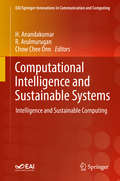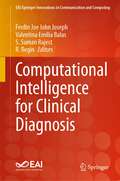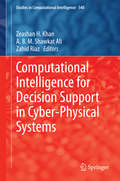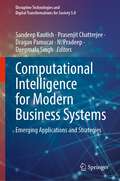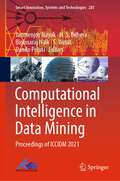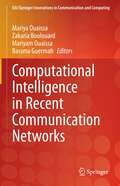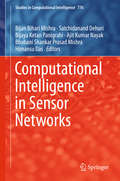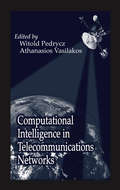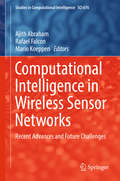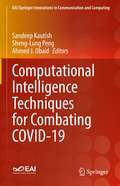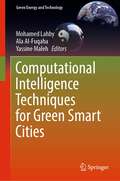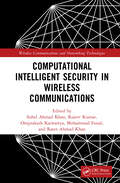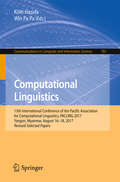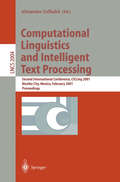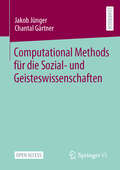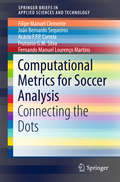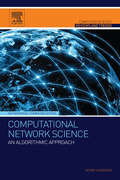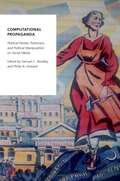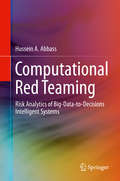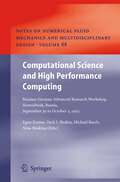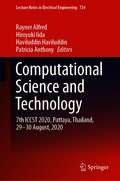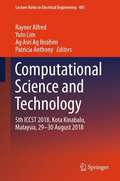- Table View
- List View
Computational Intelligence and Sustainable Systems: Intelligence and Sustainable Computing (EAI/Springer Innovations in Communication and Computing)
by H. Anandakumar R. Arulmurugan Chow Chee OnnThis book features research related to computational intelligence and energy and thermal aware management of computing resources. The authors publish original and timely research in current areas of power, energy, temperature, and environmental engineering as and advances in computational intelligence that are benefiting the fields. Topics include signal processing architectures, algorithms, and applications; biomedical informatics and computation; artificial intelligence and machine learning; green technologies in information; and more. The book includes contributions from a wide range of researchers, academicians, and industry professionals. The book is made up both of extended papers presented at the International Conference on Intelligent Computing and Sustainable System (ICICSS 2018), September 20-21, 2018, and other accepted papers on R&D and original research work related to the practice and theory of technologies to enable and support Intelligent Computing applications.
Computational Intelligence for Clinical Diagnosis (EAI/Springer Innovations in Communication and Computing)
by Ferdin Joe John Joseph Valentina Emilia Balas S. Suman Rajest R. ReginThis book contains multidisciplinary advancements in healthcare and technology through artificial intelligence (AI). The topics are crafted in such a way to cover all the areas of healthcare that require AI for further development. Some of the topics that contain algorithms and techniques are explained with the help of source code developed by the chapter contributors. The book covers the advancements in AI and healthcare from the Covid 19 pandemic and also analyzes the readiness and need for advancements in managing yet another pandemic in the future. Most of the technologies addressed in this book are added with a concept of encapsulation to obtain a cookbook for anyone who needs to reskill or upskill themselves in order to contribute to an advancement in the field. This book benefits students, professionals, and anyone from any background to learn about digital disruptions in healthcare.
Computational Intelligence for Decision Support in Cyber-Physical Systems (Studies in Computational Intelligence #540)
by Zeashan H Khan A. B. M. Shawkat Ali Zahid RiazThis book is dedicated to applied computational intelligence and soft computing techniques with special reference to decision support in Cyber Physical Systems (CPS), where the physical as well as the communication segment of the networked entities interact with each other. The joint dynamics of such systems result in a complex combination of computers, software, networks and physical processes all combined to establish a process flow at system level.This volume provides the audience with an in-depth vision about how to ensure dependability, safety, security and efficiency in real time by making use of computational intelligence in various CPS applications ranging from the nano-world to large scale wide area systems of systems.Key application areas include healthcare, transportation, energy, process control and robotics where intelligent decision support has key significance in establishing dynamic, ever-changing and high confidence future technologies. A recommended text for graduate students and researchers working on the applications of computational intelligence methods in CPS.
Computational Intelligence for Modern Business Systems: Emerging Applications and Strategies (Disruptive Technologies and Digital Transformations for Society 5.0)
by Sandeep Kautish Prasenjit Chatterjee Dragan Pamucar N. Pradeep Deepmala SinghThis book covers the applications of computational intelligence techniques in business systems and advocates how these techniques are useful in modern business operations. The book redefines the computational intelligence foundations, the three pillars - neural networks, evolutionary computation, and fuzzy systems. It also discusses emerging areas such as swarm intelligence, artificial immune systems (AIS), support vector machines, rough sets, and chaotic systems. The other areas have also been demystified in the book to strengthen the range of computational intelligence techniques such as expert systems, knowledge-based systems, and genetic algorithms. Therefore, this book will redefine the role of computational intelligence techniques in modern business system operations such as marketing, finance & accounts, operations, personnel management, supply chain management, and logistics. Besides, this book guides the readers through using them to model, discover, and interpret new patterns that cannot be found through statistical methods alone in various business system operations. This book reveals how computational intelligence can inform the design and integration of services, architecture, brand identity, and product portfolio across the entire enterprise. The book will provide insights into research gaps, open challenges, and unsolved computational intelligence problems. The book will act as a premier reference and instant material for all the users who are contributing/practicing the adaptation of computational intelligence modern techniques in business systems.
Computational Intelligence in Data Mining: Proceedings of ICCIDM 2021 (Smart Innovation, Systems and Technologies #281)
by Janmenjoy Nayak H. S. Behera Bighnaraj Naik S. Vimal Danilo PelusiThis book addresses different methods and techniques of integration for enhancing the overall goal of data mining. The book is a collection of high-quality peer-reviewed research papers presented in the Sixth International Conference on Computational Intelligence in Data Mining (ICCIDM 2021) held at Aditya Institute of Technology and Management, Tekkali, Andhra Pradesh, India, during December 11–12, 2021. The book addresses the difficulties and challenges for the seamless integration of two core disciplines of computer science, i.e., computational intelligence and data mining. The book helps to disseminate the knowledge about some innovative, active research directions in the field of data mining, machine and computational intelligence, along with some current issues and applications of related topics.
Computational Intelligence in Recent Communication Networks (EAI/Springer Innovations in Communication and Computing)
by Mariya Ouaissa Zakaria Boulouard Mariyam Ouaissa Bassma GuermahThis book focuses on the use of Artificial Intelligence and Machine Learning (AI/ML) based techniques to solve issues related to communication networks, their layers, as well as their applications. The book first offers an introduction to recent trends regarding communication networks. The authors then provide an overview of theoretical concepts of AI/ML, techniques and protocols used in different layers of communication. Furthermore, this book presents solutions that help analyze complex patterns in user data and ultimately improve productivity. Throughout, AI/ML-based solutions are provided, for topics such as signal detection, channel modeling, resource optimization, routing protocol design, transport layer optimization, user/application behavior prediction, software-defined networking, congestion control, communication network optimization, security, and anomaly detection. The book features chapters from a large spectrum of authors including researchers, students, as well as industrials involved in research and development.
Computational Intelligence in Sensor Networks (Studies in Computational Intelligence #776)
by Bijan Bihari Mishra Satchidanand Dehuri Bijaya Ketan Panigrahi Ajit Kumar Nayak Bhabani Shankar Mishra Himansu DasThis book discusses applications of computational intelligence in sensor networks. Consisting of twenty chapters, it addresses topics ranging from small-scale data processing to big data processing realized through sensor nodes with the help of computational approaches. Advances in sensor technology and computer networks have enabled sensor networks to evolve from small systems of large sensors to large nets of miniature sensors, from wired communications to wireless communications, and from static to dynamic network topology. In spite of these technological advances, sensor networks still face the challenges of communicating and processing large amounts of imprecise and partial data in resource-constrained environments. Further, optimal deployment of sensors in an environment is also seen as an intractable problem. On the other hand, computational intelligence techniques like neural networks, evolutionary computation, swarm intelligence, and fuzzy systems are gaining popularity in solving intractable problems in various disciplines including sensor networks. The contributions combine the best attributes of these two distinct fields, offering readers a comprehensive overview of the emerging research areas and presenting first-hand experience of a variety of computational intelligence approaches in sensor networks.
Computational Intelligence in Telecommunications Networks
by Witold Pedrycz Athanasios VasilakosTelecommunications has evolved and grown at an explosive rate in recent years and will undoubtedly continue to do so. As its functions, applications, and technology grow, it becomes increasingly complex and difficult, if not impossible, to meet the demands of a global network using conventional computing technologies. Computational intelligence (CI) is the technology of the future-and the future is now. Computational Intelligence in Telecommunications Networks offers an in-depth look at the rapid progress of CI technology and shows its importance in solving the crucial problems of future telecommunications networks. It covers a broad range of topics, from Call Admission Control, congestion control, and QoS-routing for ATM networks, to network design and management, optical, mobile, and active networks, and Intelligent Mobile Agents.Today's telecommunications professionals need a working knowledge of CI to exploit its potential to overcome emerging challenges. The CI community must become acquainted with those challenges to take advantage of the enormous opportunities the telecommunications field offers. This text meets both those needs, clearly, concisely, and with a depth certain to inspire further theoretical and practical advances.
Computational Intelligence in Telecommunications Networks
by Witold Pedrycz and Athanasios VasilakosTelecommunications has evolved and grown at an explosive rate in recent years and will undoubtedly continue to do so. As its functions, applications, and technology grow, it becomes increasingly complex and difficult, if not impossible, to meet the demands of a global network using conventional computing technologies. Computational intelligence (CI) is the technology of the future-and the future is now. Computational Intelligence in Telecommunications Networks offers an in-depth look at the rapid progress of CI technology and shows its importance in solving the crucial problems of future telecommunications networks. It covers a broad range of topics, from Call Admission Control, congestion control, and QoS-routing for ATM networks, to network design and management, optical, mobile, and active networks, and Intelligent Mobile Agents.Today's telecommunications professionals need a working knowledge of CI to exploit its potential to overcome emerging challenges. The CI community must become acquainted with those challenges to take advantage of the enormous opportunities the telecommunications field offers. This text meets both those needs, clearly, concisely, and with a depth certain to inspire further theoretical and practical advances.
Computational Intelligence in Wireless Sensor Networks: Recent Advances and Future Challenges (Studies in Computational Intelligence #676)
by Ajith Abraham Rafael Falcon Mario KoeppenThis book emphasizes the increasingly important role that Computational Intelligence (CI) methods are playing in solving a myriad of entangled Wireless Sensor Networks (WSN) related problems. The book serves as a guide for surveying several state-of-the-art WSN scenarios in which CI approaches have been employed. The reader finds in this book how CI has contributed to solve a wide range of challenging problems, ranging from balancing the cost and accuracy of heterogeneous sensor deployments to recovering from real-time sensor failures to detecting attacks launched by malicious sensor nodes and enacting CI-based security schemes. Network managers, industry experts, academicians and practitioners alike (mostly in computer engineering, computer science or applied mathematics) benefit from th e spectrum of successful applications reported in this book. Senior undergraduate or graduate students may discover in this book some problems well suited for their own research endeavors.
Computational Intelligence Techniques for Combating COVID-19 (EAI/Springer Innovations in Communication and Computing)
by Sandeep Kautish Sheng-Lung Peng Ahmed J. ObaidThis book presents the latest cutting edge research, theoretical methods, and novel applications in the field of computational intelligence and computational biological approaches that are aiming to combat COVID-19. The book gives the technological key drivers behind using AI to find drugs that target the virus, shedding light on the structure of COVID-19, detecting the outbreak and spread of new diseases, spotting signs of a COVID-19 infection in medical images, monitoring how the virus and lockdown is affecting mental health, and forecasting how COVID-19 cases and deaths will spread across cities and why. Further, the book helps readers understand computational intelligence techniques combating COVID-19 in a simple and systematic way.
Computational Intelligence Techniques for Green Smart Cities (Green Energy and Technology)
by Mohamed Lahby Ala Al-Fuqaha Yassine MalehThis book contains high-quality and original research on computational intelligence for green smart cities research. In recent years, the use of smart city technology has rapidly increased through the successful development and deployment of Internet of Things (IoT) architectures. The citizens' quality of life has been improved in several sensitive areas of the city, such as transportation, buildings, health care, education, environment, and security, thanks to these technological advancesComputational intelligence techniques and algorithms enable a computational analysis of enormous data sets to reveal patterns that recur. This information is used to inform and improve decision-making at the municipal level to build smart computational intelligence techniques and sustainable cities for their citizens. Machine intelligence allows us to identify trends (patterns). The smart city could better integrate its transportation network, for example. By offering a better public transportation network adapted to the demand, we could reduce personal vehicles and energy consumption. A smart city could use models to predict the consequences of a change, such as pedestrianizing a street or adding a bike lane. A city can even create a 3D digital twin to test hypothetical projects. This book comprises many state-of-the-art contributions from scientists and practitioners working in machine intelligence and green smart cities. It aspires to provide a relevant reference for students, researchers, engineers, and professionals working in this area or those interested in grasping its diverse facets and exploring the latest advances in machine intelligence for green and sustainable smart city applications.
Computational Intelligent Security in Wireless Communications (Wireless Communications and Networking Technologies)
by Suhel Ahmed Khan Rajeev Kumar Omprakash Kaiwartya Raees Ahmad Khan Mohammad FaisalWireless network security research is multidisciplinary in nature, including data analysis, economics, mathematics, forensics, information technology, and computer science. This text covers cutting-edge research in computational intelligence systems from diverse fields on the complex subject of wireless communication security. It discusses important topics including computational intelligence in wireless network and communications, artificial intelligence and wireless communication security, security risk scenarios in communications, security/resilience metrics and their measurements, data analytics of cyber-crimes, modeling of wireless communication security risks, advances in cyber threats and computer crimes, adaptive and learning techniques for secure estimation and control, decision support systems, fault tolerance and diagnosis, cloud forensics and information systems, and intelligent information retrieval. The book- Discusses computational algorithms for system modeling and optimization in security perspective. Focuses on error prediction and fault diagnosis through intelligent information retrieval via wireless technologies. Explores a group of practical research problems where security experts can help develop new data-driven methodologies. Covers application on artificial intelligence and wireless communication security risk perspective The text is primarily written for senior undergraduate, graduate students, and researchers in the fields of electrical engineering, electronics and communication engineering, and computer engineering. The text comprehensively discusses wide range of wireless communication techniques with emerging computational intelligent trends, to help readers understand the role of wireless technologies in applications touching various spheres of human life with the help of hesitant fuzzy sets based computational modeling. It will be a valuable resource for senior undergraduate, graduate students, and researchers in the fields of electrical engineering, electronics and communication engineering, and computer engineering.
Computational Intelligent Security in Wireless Communications (Wireless Communications and Networking Technologies)
by Suhel Ahmad Khan, Rajeev Kumar, Omprakash Kaiwartya, Mohammad Faisal, and Raees Ahmad KhanWireless network security research is multidisciplinary in nature, including data analysis, economics, mathematics, forensics, information technology, and computer science. This text covers cutting-edge research in computational intelligence systems from diverse fields on the complex subject of wireless communication security. It discusses important topics including computational intelligence in wireless network and communications, artificial intelligence and wireless communication security, security risk scenarios in communications, security/resilience metrics and their measurements, data analytics of cyber-crimes, modeling of wireless communication security risks, advances in cyber threats and computer crimes, adaptive and learning techniques for secure estimation and control, decision support systems, fault tolerance and diagnosis, cloud forensics and information systems, and intelligent information retrieval. The book- Discusses computational algorithms for system modeling and optimization in security perspective. Focuses on error prediction and fault diagnosis through intelligent information retrieval via wireless technologies. Explores a group of practical research problems where security experts can help develop new data-driven methodologies. Covers application on artificial intelligence and wireless communication security risk perspective The text is primarily written for senior undergraduate, graduate students, and researchers in the fields of electrical engineering, electronics and communication engineering, and computer engineering. The text comprehensively discusses wide range of wireless communication techniques with emerging computational intelligent trends, to help readers understand the role of wireless technologies in applications touching various spheres of human life with the help of hesitant fuzzy sets based computational modeling. It will be a valuable resource for senior undergraduate, graduate students, and researchers in the fields of electrical engineering, electronics and communication engineering, and computer engineering.
Computational Linguistics: 15th International Conference of the Pacific Association for Computational Linguistics, PACLING 2017, Yangon, Myanmar, August 16–18, 2017, Revised Selected Papers (Communications in Computer and Information Science #781)
by Kôiti Hasida Win Pa PaThis book constitutes the refereed proceedings of the 15th International Conference of the Pacific Association for Computational Linguistics, PACLING 2017, held in Yangon, Myanmar, in August 2017.The 28 revised full papers presented were carefully reviewed and selected from 50 submissions. The papers are organized in topical sections on semantics and semantic analysis; statistical machine translation; corpora and corpus-based language processing; syntax and syntactic analysis; document classification; information extraction and text mining; text summarization; text and message understanding; automatic speech recognition; spoken language and dialogue; speech pathology; speech analysis.
Computational Linguistics and Intelligent Text Processing: Second International Conference, CICLing 2001, Mexico-City, Mexico, February 18-24, 2001. Proceedings (Lecture Notes in Computer Science #2004)
by Alexander GelbukhCICLing 2001 is the second annual Conference on Intelligent text processing and Computational Linguistics (hence the name CICLing), see www.CICLing.org. It is intended to provide a balanced view of the cutting edge developments in both theoretical foundations of computational linguistics and practice of natural language text processing with its numerous applications. A feature of the CICLing conferences is their wide scope that covers nearly all areas of computational linguistics and all aspects of natural language processing applications. The conference is a forum for dialogue between the specialists working in these two areas. This year our invited speakers were Graeme Hirst (U. Toronto, Canada), Sylvain Kahane (U. Paris 7, France), and Ruslan Mitkov (U. Wolverhampton, UK). They delivered excellent extended lectures and organized vivid discussions. A total of 72 submissions were received, all but very few of surprisingly high quality. After careful reviewing, the Program Committee selected for presentation 53 of them, 41 as full papers and 12 as short papers, by 98 authors from 19 countries: Spain (19 authors), Japan (15), USA (12), France, Mexico (9 each), Sweden (6), Canada, China, Germany, Italy, Malaysia, Russia, United Arab Emirates (3 each), Argentina (2), Bulgaria, The Netherlands, Ukraine, UK, and Uruguay (1 each).
Computational Methods für die Sozial- und Geisteswissenschaften
by Jakob Jünger Chantal GärtnerMit Computational Methods lassen sich digitale Welten wissenschaftlich erforschen und gestalten. Das Open-Access-Lehrbuch vermittelt zunächst grundlegende Kompetenzen für die automatisierte Erhebung und Aufbereitung von Daten und für den Umgang mit Datenbanken. Eine Einführung in die Programmiersprachen R und Python sowie in Versionsverwaltungen und Cloud-Computing eröffnet Wege für kreative Analyseansätze beim Umgang mit großen und kleinen Datensätzen. Schließlich werden Szenarien in sozial- und geisteswissenschaftlichen Anwendungsfeldern durchgespielt. Dazu zählen die automatisierte Datenerhebung über Programmierschnittstellen und Webscraping, automatisierte Textanalysen, Netzwerkanalysen, maschinelles Lernen und Simulationsverfahren. Neben einer konzeptionellen Einführung in die jeweiligen Themenfelder geht es vor allem darum, in kurzen Tutorials selbst erste praktische Erfahrungen zu sammeln sowie weiterführende Möglichkeiten, aber auch Limitationen, von Computational Methods kennenzulernen.
Computational Metrics for Soccer Analysis: Connecting the dots (SpringerBriefs in Applied Sciences and Technology)
by Filipe Manuel Clemente João Bernardo Sequeiros Acácio F.P.P. Correia Frutuoso G. Silva Fernando Manuel MartinsThis book provides an account of the use of computational tactical metrics in improving sports analysis, in particular the use of Global Positioning System (GPS) data in soccer. As well as offering a practical perspective on collective behavioural analysis, it introduces the computational metrics available in the literature that allow readers to identify collective behaviour and patterns of play in team sports. These metrics only require the bio-dimensional geo-referencing information from GPS or video-tracking systems to provide qualitative and quantitative information about the tactical behaviour of players and the inter-relationships between teammates and their opponents. Exercises, experimental cases and algorithms enable readers to fully comprehend how to compute these metrics, as well as introducing them to the ultimate performance analysis tool, which is the basis to run them on. The script to compute the metrics is presented in Python. The book is a valuable resource for professional analysts as well students and researchers in the field of sports analysis wanting to optimise the use of GPS trackers in soccer.
Computational Network Science: An Algorithmic Approach (Computer Science Reviews and Trends)
by Henry HexmoorThe emerging field of network science represents a new style of research that can unify such traditionally-diverse fields as sociology, economics, physics, biology, and computer science. It is a powerful tool in analyzing both natural and man-made systems, using the relationships between players within these networks and between the networks themselves to gain insight into the nature of each field. Until now, studies in network science have been focused on particular relationships that require varied and sometimes-incompatible datasets, which has kept it from being a truly universal discipline. Computational Network Science seeks to unify the methods used to analyze these diverse fields. This book provides an introduction to the field of Network Science and provides the groundwork for a computational, algorithm-based approach to network and system analysis in a new and important way. This new approach would remove the need for tedious human-based analysis of different datasets and help researchers spend more time on the qualitative aspects of network science research.Demystifies media hype regarding Network Science and serves as a fast-paced introduction to state-of-the-art concepts and systems related to network scienceComprehensive coverage of Network Science algorithms, methodologies, and common problemsIncludes references to formative and updated developments in the fieldCoverage spans mathematical sociology, economics, political science, and biological networks
Computational Propaganda: Political Parties, Politicians, and Political Manipulation on Social Media (Oxford Studies in Digital Politics)
Social media platforms do not just circulate political ideas, they support manipulative disinformation campaigns. While some of these disinformation campaigns are carried out directly by individuals, most are waged by software, commonly known as bots, programmed to perform simple, repetitive, robotic tasks. Some social media bots collect and distribute legitimate information, while others communicate with and harass people, manipulate trending algorithms, and inundate systems with spam. Campaigns made up of bots, fake accounts, and trolls can be coordinated by one person, or a small group of people, to give the illusion of large-scale consensus. Some political regimes use political bots to silence opponents and to push official state messaging, to sway the vote during elections, and to defame critics, human rights defenders, civil society groups, and journalists. This book argues that such automation and platform manipulation, amounts to a new political communications mechanism that Samuel Woolley and Philip N. Noward call "computational propaganda." This differs from older styles of propaganda in that it uses algorithms, automation, and human curation to purposefully distribute misleading information over social media networks while it actively learns from and mimicks real people so as to manipulate public opinion across a diverse range of platforms and device networks. This book includes cases of computational propaganda from nine countries (both democratic and authoritarian) and four continents (North and South America, Europe, and Asia), covering propaganda efforts over a wide array of social media platforms and usage in different types of political processes (elections, referenda, and during political crises).
COMPUTATIONAL PROPAGANDA OSDP C: Political Parties, Politicians, and Political Manipulation on Social Media (Oxford Studies in Digital Politics)
by Samuel C. Woolley and Philip N. HowardSocial media platforms do not just circulate political ideas, they support manipulative disinformation campaigns. While some of these disinformation campaigns are carried out directly by individuals, most are waged by software, commonly known as bots, programmed to perform simple, repetitive, robotic tasks. Some social media bots collect and distribute legitimate information, while others communicate with and harass people, manipulate trending algorithms, and inundate systems with spam. Campaigns made up of bots, fake accounts, and trolls can be coordinated by one person, or a small group of people, to give the illusion of large-scale consensus. Some political regimes use political bots to silence opponents and to push official state messaging, to sway the vote during elections, and to defame critics, human rights defenders, civil society groups, and journalists. This book argues that such automation and platform manipulation, amounts to a new political communications mechanism that Samuel Woolley and Philip N. Noward call "computational propaganda." This differs from older styles of propaganda in that it uses algorithms, automation, and human curation to purposefully distribute misleading information over social media networks while it actively learns from and mimicks real people so as to manipulate public opinion across a diverse range of platforms and device networks. This book includes cases of computational propaganda from nine countries (both democratic and authoritarian) and four continents (North and South America, Europe, and Asia), covering propaganda efforts over a wide array of social media platforms and usage in different types of political processes (elections, referenda, and during political crises).
Computational Red Teaming: Risk Analytics of Big-Data-to-Decisions Intelligent Systems (Ieee Press Series On Computational Intelligence Ser.)
by Hussein A. AbbassWritten to bridge the information needs of management and computational scientists, this book presents the first comprehensive treatment of Computational Red Teaming (CRT). The author describes an analytics environment that blends human reasoning and computational modeling to design risk-aware and evidence-based smart decision making systems. He presents the Shadow CRT Machine, which shadows the operations of an actual system to think with decision makers, challenge threats, and design remedies. This is the first book to generalize red teaming (RT) outside the military and security domains and it offers coverage of RT principles, practical and ethical guidelines. The author utilizes Gilbert’s principles for introducing a science. Simplicity: where the book follows a special style to make it accessible to a wide range of readers. Coherence: where only necessary elements from experimentation, optimization, simulation, data mining, big data, cognitive information processing, and system thinking are blended together systematically to present CRT as the science of Risk Analytics and Challenge Analytics. Utility: where the author draws on a wide range of examples, ranging from job interviews to Cyber operations, before presenting three case studies from air traffic control technologies, human behavior, and complex socio-technical systems involving real-time mining and integration of human brain data in the decision making environment.
Computational Science and High Performance Computing: Russian-German Advanced Research Workshop, Novosibirsk, Russia, September 30 to October 2, 2003 (Notes on Numerical Fluid Mechanics and Multidisciplinary Design #88)
by Egon Krause Yurii I. Shokin Nina ShokinaThisvolumeispublishedastheproceedingsoftheRussian-GermanAdvanced Research workshop on Computational Science and High Performance C- puting in Novosibirsk Academgorodok in September 2003. The contributions of these proceedings were provided and edited by the authors, chosen after a careful selection and reviewing. The workshop was organized by the Institute of Computational Techno- gies SB RAS (Novosibirsk, Russia) and the High Performance Computing Center Stuttgart (Stuttgart, Germany). The objective was the discussion of the latest results in computational science and to develop a close coope- tion between Russian and German specialists in the above-mentioned ?eld. The main directions of the workshop are associated with the problems of computational hydrodynamics, application of mathematical methods to the development of new generation of materials, environment protection pr- lems, development of algorithms, software and hardware support for hi- performance computation, and designing modern facilities for visualization of computational modelling results. The importance of the workshop topics was con?rmed by the partici- tion of representatives of major research organizations engaged in the so- tion of the most complex problems of mathematical modelling, development of new algorithms, programs and key elements of new information techno- gies. Among the Russian participants were researchers of the Institutes of the Siberian Branch of the Russian Academy of Sciences: Institute of Com- tational Technologies, Institute of Computational Mathematics and Mat- matical Geophysics, Institute of Computational Modelling, Russian Federal Nuclear Center, All-Russian Research Institute of Experimental Physics, - merovo State University.
Computational Science and Technology: 7th ICCST 2020, Pattaya, Thailand, 29–30 August, 2020 (Lecture Notes in Electrical Engineering #724)
by Rayner Alfred Hiroyuki Iida Haviluddin Haviluddin Patricia AnthonyThis book gathers the proceedings of the Seventh International Conference on Computational Science and Technology 2020 (ICCST 2020), held in Pattaya, Thailand, on 29–30 August 2020. The respective contributions offer practitioners and researchers a range of new computational techniques and solutions, identify emerging issues, and outline future research directions, while also showing them how to apply the latest large-scale, high-performance computational methods.
Computational Science and Technology: 5th ICCST 2018, Kota Kinabalu, Malaysia, 29-30 August 2018 (Lecture Notes in Electrical Engineering #481)
by Rayner Alfred Yuto Lim Ag Asri Ibrahim Patricia AnthonyThis book features the proceedings of the Fifth International Conference on Computational Science and Technology 2018 (ICCST2018), held in Kota Kinabalu, Malaysia, on 29–30 August 2018. Of interest to practitioners and researchers, it presents exciting advances in computational techniques and solutions in this area. It also identifies emerging issues to help shape future research directions and enable industrial users to apply cutting-edge, large-scale and high-performance computational methods.
